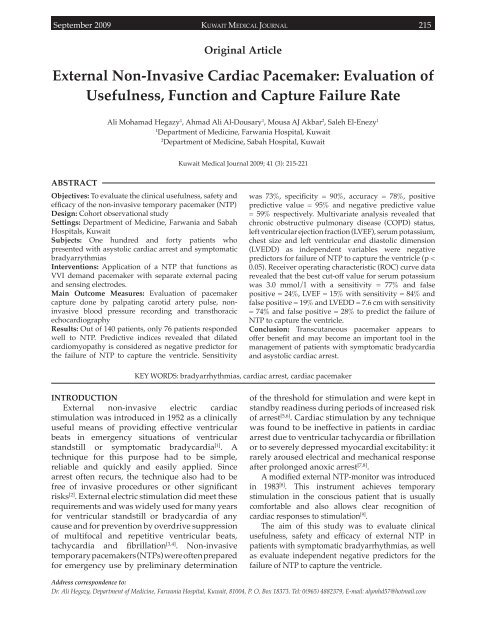Vol 41 # 3 September 2009 - Kma.org.kw
Vol 41 # 3 September 2009 - Kma.org.kw
Vol 41 # 3 September 2009 - Kma.org.kw
You also want an ePaper? Increase the reach of your titles
YUMPU automatically turns print PDFs into web optimized ePapers that Google loves.
<strong>September</strong> <strong>2009</strong><br />
KUWAIT MEDICAL JOURNAL 215<br />
Original Article<br />
External Non-Invasive Cardiac Pacemaker: Evaluation of<br />
Usefulness, Function and Capture Failure Rate<br />
Ali Mohamad Hegazy 1 , Ahmad Ali Al-Dousary 1 , Mousa AJ Akbar 2 , Saleh El-Enezy 1<br />
1<br />
Department of Medicine, Farwania Hospital, Kuwait<br />
2<br />
Department of Medicine, Sabah Hospital, Kuwait<br />
Kuwait Medical Journal <strong>2009</strong>; <strong>41</strong> (3): 215-221<br />
ABSTRACT<br />
Objectives: To evaluate the clinical usefulness, safety and<br />
efficacy of the non-invasive temporary pacemaker (NTP)<br />
Design: Cohort observational study<br />
Settings: Department of Medicine, Farwania and Sabah<br />
Hospitals, Kuwait<br />
Subjects: One hundred and forty patients who<br />
presented with asystolic cardiac arrest and symptomatic<br />
bradyarrythmias<br />
Interventions: Application of a NTP that functions as<br />
VVI demand pacemaker with separate external pacing<br />
and sensing electrodes.<br />
Main Outcome Measures: Evaluation of pacemaker<br />
capture done by palpating carotid artery pulse, noninvasive<br />
blood pressure recording and transthoracic<br />
echocardiography<br />
Results: Out of 140 patients, only 76 patients responded<br />
well to NTP. Predictive indices revealed that dilated<br />
cardiomyopathy is considered as negative predictor for<br />
the failure of NTP to capture the ventricle. Sensitivity<br />
was 73%, specificity = 90%, accuracy = 78%, positive<br />
predictive value = 95% and negative predictive value<br />
= 59% respectively. Multivariate analysis revealed that<br />
chronic obstructive pulmonary disease (COPD) status,<br />
left ventricular ejection fraction (LVEF), serum potassium,<br />
chest size and left ventricular end diastolic dimension<br />
(LVEDD) as independent variables were negative<br />
predictors for failure of NTP to capture the ventricle (p <<br />
0.05). Receiver operating characteristic (ROC) curve data<br />
revealed that the best cut-off value for serum potassium<br />
was 3.0 mmol/l with a sensitivity = 77% and false<br />
positive = 24%, LVEF = 15% with sensitivity = 84% and<br />
false positive = 19% and LVEDD = 7.6 cm with sensitivity<br />
= 74% and false positive = 28% to predict the failure of<br />
NTP to capture the ventricle.<br />
Conclusion: Transcutaneous pacemaker appears to<br />
offer benefit and may become an important tool in the<br />
management of patients with symptomatic bradycardia<br />
and asystolic cardiac arrest.<br />
KEY WORDS: bradyarrhythmias, cardiac arrest, cardiac pacemaker<br />
INTRODUCTION<br />
External non-invasive electric cardiac<br />
stimulation was introduced in 1952 as a clinically<br />
useful means of providing effective ventricular<br />
beats in emergency situations of ventricular<br />
standstill or symptomatic bradycardia [1] . A<br />
technique for this purpose had to be simple,<br />
reliable and quickly and easily applied. Since<br />
arrest often recurs, the technique also had to be<br />
free of invasive procedures or other significant<br />
risks [2] . External electric stimulation did meet these<br />
requirements and was widely used for many years<br />
for ventricular standstill or bradycardia of any<br />
cause and for prevention by overdrive suppression<br />
of multifocal and repetitive ventricular beats,<br />
tachycardia and fibrillation [3,4] . Non-invasive<br />
temporary pacemakers (NTPs) were often prepared<br />
for emergency use by preliminary determination<br />
of the threshold for stimulation and were kept in<br />
standby readiness during periods of increased risk<br />
of arrest [5,6] . Cardiac stimulation by any technique<br />
was found to be ineffective in patients in cardiac<br />
arrest due to ventricular tachycardia or fibrillation<br />
or to severely depressed myocardial excitability: it<br />
rarely aroused electrical and mechanical response<br />
after prolonged anoxic arrest [7,8] .<br />
A modified external NTP-monitor was introduced<br />
in 1983 [8] . This instrument achieves temporary<br />
stimulation in the conscious patient that is usually<br />
comfortable and also allows clear recognition of<br />
cardiac responses to stimulation [9] .<br />
The aim of this study was to evaluate clinical<br />
usefulness, safety and efficacy of external NTP in<br />
patients with symptomatic bradyarrhythmias, as well<br />
as evaluate independent negative predictors for the<br />
failure of NTP to capture the ventricle.<br />
Address correspondence to:<br />
Dr. Ali Hegazy, Department of Medicine, Farwania Hospital, Kuwait, 81004, P. O, Box 18373. Tel: 0(965) 4882379, E-mail: alymhd57@hotmail.com
















